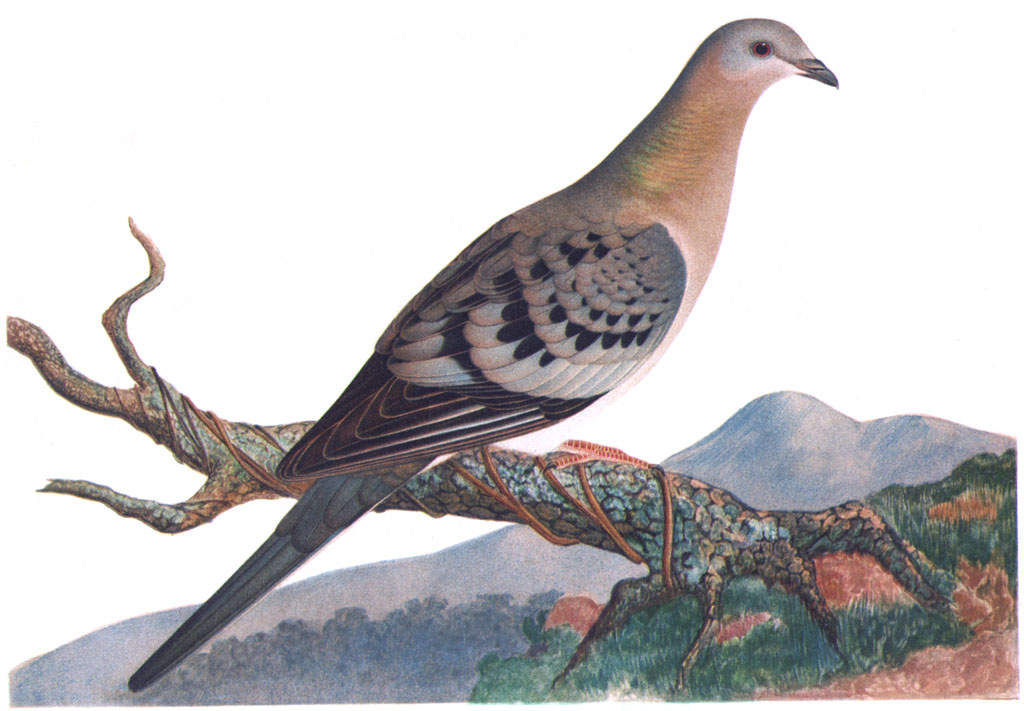Don't worry, come Monday, this endless barrage of posts and reminders of how many species we have destroyed will cease. If you don't post five comments from at least two different people, that is.
Anyway, I'm going to talk about a species that regularly caused solar eclipses. Just flocks reached up into the millions, blocking the sun totally from sight. They represented up to 40% of the bird population of North America, with numbers sometimes estimated at 6 billion. If you live in Singapore, you'll know how common mynahs are. Just multiply that commonness by about a 1000. Yeah. That's what I'm talking about.
 The passenger pigeon seemed destined for survival, and survival in almost annoying numbers, to probably pest levels. Twas not to be. Some enterprising hunter somewhere shot one down and ate it in the 1800s. That was its killing. It always been used for food, but somehow this flavorful revelation was greater than all those before. It was discovered to have great culinary flavor and instantly people all over the US were demanding it and hunters were more than happy to comply. It was a pigeon killing spree. Since they flocked, and nested, in such large numbers, it was easy for hunters to come in and just kill, kill, kill them. Break their eggs, strangle the babies, shoot the adults. Vicious. It was easy to lay huge nets and watch as a huge flock flew into it, entangling it, and trapping it, and instant fodder for the city markets. No one noticed when numbers started decreasing in the mid 1800s. No one noticed as the huge flocks covering the sun slowly decreased. No one noticed but a couple of government officials and conservationists who passed a bill forbidding the netting of passenger pigeons within 2 miles of nesting areas. Was that bill obeyed? You take a guess.
The passenger pigeon seemed destined for survival, and survival in almost annoying numbers, to probably pest levels. Twas not to be. Some enterprising hunter somewhere shot one down and ate it in the 1800s. That was its killing. It always been used for food, but somehow this flavorful revelation was greater than all those before. It was discovered to have great culinary flavor and instantly people all over the US were demanding it and hunters were more than happy to comply. It was a pigeon killing spree. Since they flocked, and nested, in such large numbers, it was easy for hunters to come in and just kill, kill, kill them. Break their eggs, strangle the babies, shoot the adults. Vicious. It was easy to lay huge nets and watch as a huge flock flew into it, entangling it, and trapping it, and instant fodder for the city markets. No one noticed when numbers started decreasing in the mid 1800s. No one noticed as the huge flocks covering the sun slowly decreased. No one noticed but a couple of government officials and conservationists who passed a bill forbidding the netting of passenger pigeons within 2 miles of nesting areas. Was that bill obeyed? You take a guess.No one noticed at all till there was only a couple of lone passenger pigeons left, scattered in zoos. Then people tried to get them to breed, but passenger pigeons rely on their huge flock numbers for breeding.
People noticed when the last passenger pigeon named Martha died in the Cincinnati Zoological Garden on the 1st of September, 1914. People noticed. But it was too late. It was far too late.
The Glasswing Butterfly

No comments:
Post a Comment
Hello, commenter.
Nice to know you're showing interest in what we're doing. The Glasswing Butterfly and the Blobfish urge you to be nice while commenting and will hunt you down and find you if you aren't. You don't want to see a near-invisible butterfly and a gloppy slimy blob outside your front door. Trust me.